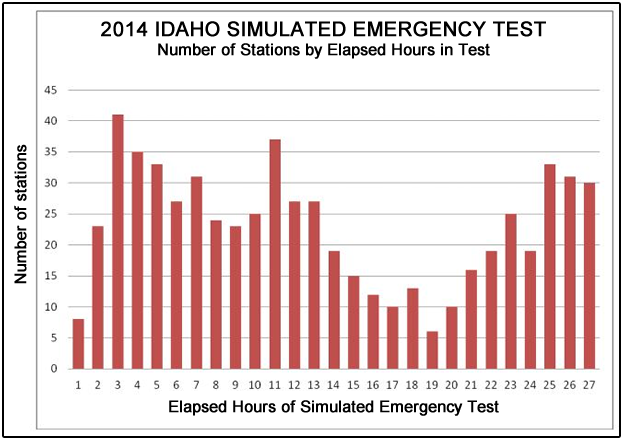|
|
Report on success of recent emergency test of
Idaho ham radio |
|
November 12, 2014 |
by Michael Meier
American Radio Relay League Idaho SEC
As the Idaho Section Emergency Coordinator of
the American Radio Relay League (the national
association for Amateur Radio--or Ham Radio--in
the United States), I am always looking for ways
to get our local Idaho Amateur Radio Operators
involved, to get them moving, and to have fun.
Every year we plan and participate in our local
Idaho Simulated Emergency Test. We try to base
the operation and feel of the Test in a way
fitting our unique geographic conditions.
For three years now we have engaged in our own
game, the Idaho way, training as we go and still
having fun. For two years we entered messages
into the system as a Radiogram and ICS213 (a
form used for communication in emergency
incidents) with specific instructions within
each message to move it forward, but note how
and who sent it to you in an After Action Report
sent to the Section Emergency Coordinator. This
way we could measure the width and breadth of
our penetration into our state and neighboring
states. Accuracy was also important, and the
After Action Reports gave us the details we
needed to identify where we needed improvement.
This year however was different.
One of my Counties (Latah) was planning a
County-wide Exercise which involved 24 hours of
operation including all modes, Voice, Digital,
and CW (Morse code). Bill Ward, K9GRZ, the
planner of this operation, wanted to know if I
could help him expand to other counties to give
them more check-ins and make it more real.
The K9GRZ exercise of Latah County sounded like
the perfect opportunity for a Simulated
Emergency Test (SET) to me, so we started a
campaign to get the word out via our fabulous
website
www.idahoares.info , also via email, club
notification, and by posted news such as the
newsbf.com website.
Our little simulated test developed legs, and
before you knew it we had a region of Amateur
Operators interested in participating.
Now this simulated test was not between big
boomer stations with amplifiers and antennas at
300 feet, but rather a Net Control in a tent,
out in the wilds, running normal power, portable
antennas, and anything but the best of operating
conditions. We wanted to see what happens in the
real world!
In the real world our Amateur Operators would be
asked to communicate for an extended period of
time, not just during a simple net, but maybe
days, with little relief. If things were bad we
would not have the mega stations, mega antennas,
and teams of operators. So our test reflected
that exact situation.
Some stations in several counties were set up at
the local Emergency Operation Centers; others
teamed up and went portable like Field Day. In
the true spirit of Amateur Radio Emergency
Service and Amateur Radio, Operators set up for
the duration.
Starting at 1900 Zulu on October 11, 2014 our
Simulated Emergency Test began (two hours of
early check-ins to confirm things worked) with
stations working Single Side Band radio for the
first 20 minutes of the hour, then Digital PSK31
for the next 20 minutes, and CW for the last 20.
Stations working all three modes were really
kept busy, and it did not stop for 24 hours (26
hours for the early birds).
On top of all this check-in action, local groups
and communities were encouraged to take VHF-UHF
check-ins and relay those stations in, which
were included in the After Action Reports of all
operators, not on the air due to limits in time.
All totalled, Idaho had roughly 1,400 check-ins
to our Simulated Emergency Test in 24 hours.
During that time we moved the Net frequency from
80 meters to 40 meters as the band went in and
out as smoothly as switching a band switch
(almost!).
Talk about fun, and a challenge, to operate for
24 hours, multimode, under less than ideal
conditions. This, my friends, weeds out the men
from the boys, so to speak.
The breakdown on our simulated test was 619
Single Side Band contacts from 24 Idaho
counties, eight different states, and 88
individual stations. CW was 219 contacts from
all six Idaho districts, eight states and 24
individual stations. Digital PSK31 was 127
contacts from 12 counties, five states, and 31
individual stations. VHF was 424 contacts from
96 stations, for a total of 1,389 contacts from
239 stations.
This breakdown does not account for logging
errors or missed calls by stations that could
not get relayed in or were buried in the pile
ups, so totals are likely greater than
indicated.
The accompanying graph shown below indicates the
number of check-ins throughout the Simulated
Emergency Test, and shows how many operated
round the clock for this 24 hour exercise.

|
|
|
|
Questions or comments about this
article?
Click here to e-mail! |
|
|
|
|

